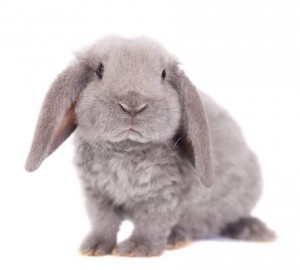Minimum Size | Outdoor Hutches | Indoor Cages | Build a Hutch
If you are looking for a home for your new pet rabbit, this article will provide you with all the information you will need to make an informed decision about selecting an appropriate habitat for them. There are several options of rabbit cages and hutches and deciding on which one will depend on several factors. These include the size and type of your rabbit, how much space you have for habitat, the budget you have for building or buying a rabbit house, and whether you intended to keep your new pet indoors or outdoors.
Housing Size Requirements
While you can never have too large of habitat, you can have too small of one. There are a few minimum requirements that need to be met and if you can’t provide these, you should instead consider getting a smaller pet like a hamster, guinea pig, or chinchilla. For one rabbit (even dwarf size bunnies), the minimum length of a cage must be at least 4 feet (122cm). That’s about three hops long. In terms of width, the minimum length needs to be at least 2 feet (61cm). That’s about 1.5 hops wide. The height of the cage needs to be tall enough for your pet bunny to stand straight up without having its ears touch the roof of the cage. Roughly, that should be about 18 to 24 inches (46-61cm) high.

You rabbit’s cage should be a minimum of L 2′ x W 4′ x H 18-24″ (61cm x 122cm x 46-61cm). If you can’t provide this, don’t keep a rabbit as a pet.
If you go to a pet store to purchase a rabbit hutch or cage, be aware that not all of the options available are big enough for a rabbit. Even if the sticker says, suitable for rabbits and bunnies, if it doesn’t meet the minimum size requirements, avoid purchasing it. Furthermore, if you think a smaller cage will be okay because you plan to let your little guy hop around the yard every day, if you can’t say for certain that you will be home every single day to do this, don’t get that smaller cage. There might be a time you go on vacation or can’t make it home for some unforeseen reason.
Indoor vs Outdoor Habitats
A rabbit hutch is a type of structure intended to house pet rabbits. Specifically, they are habitats that are placed outside in a backyard, or on an outdoor patio. An indoor cage is typically a smaller habitat that is portable. Below we will discuss the pros and cons of choosing to house your pets inside or outside in these various structures.
Outdoor Rabbit Hutches
It’s not a good plan to simply let a pet bunny rabbit live in a fenced backyard, it likely won’t last long. You need to build or purchase a hutch or a cage. No matter how secure your fencing is, predators will have little trouble getting into your backyard. The other thing to know is that some states or cities have laws about allowing pet rabbits to be housed outside. The reason for these laws is to limit the possibility for your rabbits to get out, breed, and ruin the ecosystem by out-competing native species for the limited resources in the area. For this reason, look into your local laws and see if it is allowed.
Outdoor hutches used to be the only way to keep pet rabbits but now that more research has been done on rabbit care, these homes are not as popular of an option anymore. Rabbits in these types of cages often become neglected by their owners. Your bunnies need to be able to get out every day to stretch their legs every day and if an owner thinks of their hutch as a type of fish tank, their rabbits won’t have a good quality of life since they will be confined to a small space for long periods of time. Additionally, a bunny kept out in the elements will have to contend with the heat of summer, the cold of winter, and any number of predators.
If you can’t provide this standard of care, you risk your pets falling ill to a list of rabbit health problems. Some of these issues are not too much to be concerned about while others can lead to expensive vet visits and a shortened lifespan of your pet. This is why housing your bunny indoors is the preferred method these days.
However, if you are a good owner, you can successfully keep a pet rabbit outdoors by sticking to some of these rules:
- Get the largest hutch you can afford and have space for.
- Place it in a location that is NOT in the sunlight for long periods of the day or in cold drafty areas.
- Must have good ventilation to avoid ammonia build-up. (10 air exchanges per hour)
- Ensure all the latches and sides are secure enough to keep any predators out (mosquito nets when needed).
- Add a hide box so your bunnies have a place to retreat and hide in when they become stressed.
Indoor Rabbit Cages
- It’s much easier to train them to be handled and come when you call them.
- Your bunnies will have the ability to roam freely and interact with you on a daily basis.
- You can observe their behavior more easily and spot signs of illness sooner than if they lived outside.
- They are protected from the elements and predators and less likely to become ill.
Similar to the reason why you shouldn’t let your rabbits roam free unsupervised in your backyard, you should take similar precautions and provide them with a cage for their protection and the protection of your possessions. This is especially important if you have other pets in the house that might want to uses your pet rabbit as a chew toy. You should place your bunny’s cage in a draft-free, non-damp location that is quiet but not isolated. You should avoid placing it on the floor or near a drafty window or doors.
This cage should be portable and doesn’t need to be as large as an outdoor hutch. It won’t require a solid roof or any mosquito screening. The cage should have a large access door on the side and top for cleaning purposes. To make you bunny feel more at home, you should provide it with a small hide box that it can retreat to. This especially important if you have a house full of children or high traffic volume.

How to Build a Rabbit Hutch Outside
If you make the decision to keep your pet in a rabbit hutch outside, you can either choose to buy a rabbit hutch from a manufacturer or build one on your own based on available plans. If you are handy with woodworking tools and have experience building things, you can probably come up with a plan of your own. Know this though, there are certain materials you should avoid using:
- It’s important to avoid using any woods that are toxic to rabbits such as cedar, pine, or pressure-treated woods. These types of woods give off toxic odors that can cause a list of rabbit health problems including just a few: eye irritation, respiratory and kidney failure.
- Avoid using sheet metals on the roof or walls since these are great conductors of heat and in a sense, cold. If you use metal, you significantly increase the chance of your pet bunny rabbit from heat exhaustion or hypothermia; not just during extreme temperatures but even mild temps.
Building materials
- Chicken Wire (strong type)
- Wire Mesh 14 and 16 gauge
- Hardware Cloth
- Latches and Hinges
- Braces and Brackets
- Screws and Fasteners
- Formaldehyde-Free Plywood
- Wooden Boards or planks
- 1×2, 2×4 and 4×4 lumber
For the bottom of the hutch, use 1/2 inch square (1.2cm) hardware cloth or a 16 gauge wire mesh of: 1/2″ x 1/2″ (1.2cm), 1/2″ x 1″ (1.2cm x 2.5cm) or 1/2″ x 2″ (1.2cm x 5.1cm). This allows droppings to fall but not your rabbit’s feet.
For the side 14 gauge wire mesh of 1″ x 2″ (2.5 x 5.1cm). This wire mesh is also called ‘rabbit wire’. Using these minimum standards for building your rabbit’s hutch, will ensure it’s stability and security to keep your bunnies in and predators out.
If you add a litter box, you can use plywood for the bottom, but, it’s still best to use a system that allows dropping fall to the ground or into a removable tray.
Step-by-Step guides
There are a lot of plans available on the internet for download or books full of plans on building a number of projects including hutches. When selecting a plan, take into consideration all the dos and don’ts we provided above. If a plan calls for lesser grade material or toxic woods, upgrade those to the minimum standards listed here. Finally, choose a plan that you know your rabbits will be happy in and think about how you might modify it to ensure that. Build it in a way that you can add additions easily. The following are some resources and plans for hutches and cages.
- Rabbit Hutch – How to Build Rabbit Hutch Plans for Indoors or Outdoors..For Cheap!
- How to Build Animal Housing: 60 Plans
- Outdoor Woodwork: 16 Easy-To-Build Projects for Your Yard & Garden
Additional Information:
Reviewed By: Tim Winter

Tim Winter has a strong affection for pets and wildlife. His years of experience caring for various types of pets has led him to share his knowledge with others on the best practices in pet care. Tim holds a Bachelor of Science from the University of Oregon School of Journalism and Communications.

lovley it worked